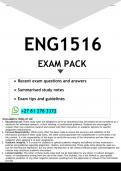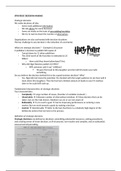Summary Articles Health Communication
Exam 2
Master track Persuasive Communication
Course Health Communication
Year 2020-2021
Ivo Martens
, 2
Index
Moyer-Gusé, 2008 ................................................................................................................................... 3
De Graaf, Sanders and Hoeken, 2016...................................................................................................... 8
Murphy et al., 2013 ............................................................................................................................... 13
Rothman et al., 2006 ........................................................................................................................ 17
Gallagher & Updegraff, 2012................................................................................................................. 21
Covey, 2014 ........................................................................................................................................ 23
Mayer & Moreno, 2003 ......................................................................................................................... 25
Bol et al., 2015 .................................................................................................................................. 31
Meppelink et al., 2015........................................................................................................................... 33
Hawking et al., 2008 ......................................................................................................................... 37
Van Stralen et al., 2009 ......................................................................................................................... 41
Kreuter & McClure, 2004....................................................................................................................... 43
UvA, Persuasive Communication, Health Communication Ivo Martens
, 3
Week 9 Storytelling
Moyer-Gusé, 2008
Toward a theory of entertainment persuasion: explaining the persuasive effects of
entertainment-education messages
What does it research?
The involvement with narrative storylines and characters that is fostered by entertainment
programming. & It reviews and synthesizes existing theories that have addressed entertainment-
education message processing. & It presents an expanded theoretical framework.
What is the main outcome?
See figure 1 and the accompanying propositions (7).
Generally speaking previous studies have found that prosocial messages embedded in entertainment
television programs can influence viewers’ awareness and attitudes towards the issues they cover.
Some have speculated that entertainment-education may offer a more effective way to influence
attitudes and behavior than traditional persuasive message by arousing less resistance to the
persuasive messages contained within a narrative.
Because the narrative structure one might be more involved with the characters therein. This
involvement may help to overcome various forms of resistance to persuasion. Unfortunately, much
conceptual confusion exists in the literature on involvement.
To this end, the present article begins with an overview of involvement in the context of
entertainment-education messages. This discussion focuses on viewers’ involvement with a narrative
itself as well as with characters, defining and distinguishing several related constructs, such as
identification, wishful identification, parasocial interaction (PSI), similarity and transportation.
Defining entertainment-education
Entertainment-education -> prosocial messages that are embedded into popular entertainment
media content.
Narrative persuasion -> Messages with a feature of promoting healthy and/or prosocial behaviors
and or negatively portraying ‘risky behaviours’
Examining involvement in entertainment-education
Narrative involvement
Because of their narrative structure, entertainment-education message foster involvement in the
storyline. Involvement in this sense refers to the interest with which viewers follow the events as
they unfold in the story. The main idea is consistently that of being primarily engaged in the storyline,
rather than in one’s immediate environment, and experiencing vicarious cognitive and emotional
responses to the narrative as it unfolds. Perhaps most commonly used is the term transportation.
Transportation -> a convergent process, where all mental systems and capacities become focused on
events occurring in the narrative.
This notion of being swept up into the storyline distinguishes entertainment-education message
processing from that of overtly persuasive messages.
UvA, Persuasive Communication, Health Communication Ivo Martens
, 4
Involvement with characters
Identification -> an emotional and cognitive process whereby a viewer takes on the role of a
character in a narrative.
The viewer forgets about his or her own reality and temporarily becomes the character, taking on the
character’s perspective. This process involves four dimensions:
- Empathic
o Shared feelings with the characters
- Cognitive
o Sharing the character’s perspective
- Motivational
o Internalizing the character’s goals
- Absorption
o The loss of self-awareness during exposure
One issues that needs to be addressed here is the extent to which identification and transportation
are isomorphic. Notice that the fourth dimension in the definition of ident cation, absorption,
overlaps with the defection of transportation. Despite this overlap, identification goes beyond
transportation by also including three other dimensions directed at one particular character within
the narrative rather than a storyline overall.
Wishful identification
Wishful identification -> When a viewer wants to be like the character, experiences an active ‘desire
to emulate the figure’, and looks up to the character.
This idea has been explored by social cognitive theory (SCT), where viewers are expected to emulate
attractive models. Identification is distinct from wishful identification in that it represents and
emotional and cognitive process, whereby the viewer takes on the role of the character he is viewing,
rather than a desire to make himself or herself more like the character.
Similarity
Perceived similarity -> the degree to which an individual perceives that he or she is similar to a
character. Can refer to physical attributes, demographic variables, beliefs, personality, or values.
Similarity refers to a cognitive assessment of what one has in common with a character, whereas
identification is characterized by empathy, shared emotions, and a loss of self-awareness. In this way,
similarity involves maintaining one’s own perspective while making judgments about a character,
whereas identification requires taking on the role of and experiencing event as a character.
Parasocial interaction
PSI -> the seeming face-to-face relationship between spectators and performer. This refer to the
interaction between an audience member and a media figure such that a pseudo relationship forms.
Liking
Liking -> positive evaluations of a character
Liking is similar to PSI in that it involves an evaluation of a character and some desire for a friendship.
UvA, Persuasive Communication, Health Communication Ivo Martens
Exam 2
Master track Persuasive Communication
Course Health Communication
Year 2020-2021
Ivo Martens
, 2
Index
Moyer-Gusé, 2008 ................................................................................................................................... 3
De Graaf, Sanders and Hoeken, 2016...................................................................................................... 8
Murphy et al., 2013 ............................................................................................................................... 13
Rothman et al., 2006 ........................................................................................................................ 17
Gallagher & Updegraff, 2012................................................................................................................. 21
Covey, 2014 ........................................................................................................................................ 23
Mayer & Moreno, 2003 ......................................................................................................................... 25
Bol et al., 2015 .................................................................................................................................. 31
Meppelink et al., 2015........................................................................................................................... 33
Hawking et al., 2008 ......................................................................................................................... 37
Van Stralen et al., 2009 ......................................................................................................................... 41
Kreuter & McClure, 2004....................................................................................................................... 43
UvA, Persuasive Communication, Health Communication Ivo Martens
, 3
Week 9 Storytelling
Moyer-Gusé, 2008
Toward a theory of entertainment persuasion: explaining the persuasive effects of
entertainment-education messages
What does it research?
The involvement with narrative storylines and characters that is fostered by entertainment
programming. & It reviews and synthesizes existing theories that have addressed entertainment-
education message processing. & It presents an expanded theoretical framework.
What is the main outcome?
See figure 1 and the accompanying propositions (7).
Generally speaking previous studies have found that prosocial messages embedded in entertainment
television programs can influence viewers’ awareness and attitudes towards the issues they cover.
Some have speculated that entertainment-education may offer a more effective way to influence
attitudes and behavior than traditional persuasive message by arousing less resistance to the
persuasive messages contained within a narrative.
Because the narrative structure one might be more involved with the characters therein. This
involvement may help to overcome various forms of resistance to persuasion. Unfortunately, much
conceptual confusion exists in the literature on involvement.
To this end, the present article begins with an overview of involvement in the context of
entertainment-education messages. This discussion focuses on viewers’ involvement with a narrative
itself as well as with characters, defining and distinguishing several related constructs, such as
identification, wishful identification, parasocial interaction (PSI), similarity and transportation.
Defining entertainment-education
Entertainment-education -> prosocial messages that are embedded into popular entertainment
media content.
Narrative persuasion -> Messages with a feature of promoting healthy and/or prosocial behaviors
and or negatively portraying ‘risky behaviours’
Examining involvement in entertainment-education
Narrative involvement
Because of their narrative structure, entertainment-education message foster involvement in the
storyline. Involvement in this sense refers to the interest with which viewers follow the events as
they unfold in the story. The main idea is consistently that of being primarily engaged in the storyline,
rather than in one’s immediate environment, and experiencing vicarious cognitive and emotional
responses to the narrative as it unfolds. Perhaps most commonly used is the term transportation.
Transportation -> a convergent process, where all mental systems and capacities become focused on
events occurring in the narrative.
This notion of being swept up into the storyline distinguishes entertainment-education message
processing from that of overtly persuasive messages.
UvA, Persuasive Communication, Health Communication Ivo Martens
, 4
Involvement with characters
Identification -> an emotional and cognitive process whereby a viewer takes on the role of a
character in a narrative.
The viewer forgets about his or her own reality and temporarily becomes the character, taking on the
character’s perspective. This process involves four dimensions:
- Empathic
o Shared feelings with the characters
- Cognitive
o Sharing the character’s perspective
- Motivational
o Internalizing the character’s goals
- Absorption
o The loss of self-awareness during exposure
One issues that needs to be addressed here is the extent to which identification and transportation
are isomorphic. Notice that the fourth dimension in the definition of ident cation, absorption,
overlaps with the defection of transportation. Despite this overlap, identification goes beyond
transportation by also including three other dimensions directed at one particular character within
the narrative rather than a storyline overall.
Wishful identification
Wishful identification -> When a viewer wants to be like the character, experiences an active ‘desire
to emulate the figure’, and looks up to the character.
This idea has been explored by social cognitive theory (SCT), where viewers are expected to emulate
attractive models. Identification is distinct from wishful identification in that it represents and
emotional and cognitive process, whereby the viewer takes on the role of the character he is viewing,
rather than a desire to make himself or herself more like the character.
Similarity
Perceived similarity -> the degree to which an individual perceives that he or she is similar to a
character. Can refer to physical attributes, demographic variables, beliefs, personality, or values.
Similarity refers to a cognitive assessment of what one has in common with a character, whereas
identification is characterized by empathy, shared emotions, and a loss of self-awareness. In this way,
similarity involves maintaining one’s own perspective while making judgments about a character,
whereas identification requires taking on the role of and experiencing event as a character.
Parasocial interaction
PSI -> the seeming face-to-face relationship between spectators and performer. This refer to the
interaction between an audience member and a media figure such that a pseudo relationship forms.
Liking
Liking -> positive evaluations of a character
Liking is similar to PSI in that it involves an evaluation of a character and some desire for a friendship.
UvA, Persuasive Communication, Health Communication Ivo Martens






